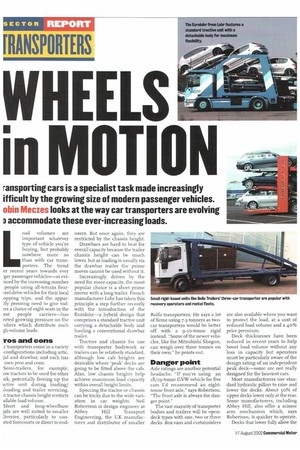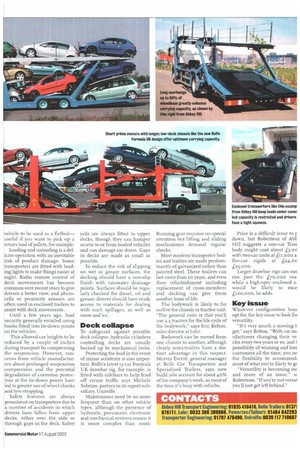WHEELS in RIOT
Page 34

Page 35

If you've noticed an error in this article please click here to report it so we can fix it.
ransporting cars is a specialist task made increasingly ifficult by the growing size of modern passenger vehicles. obin Meczes looks at the way car transporters are evolving 3 accommodate these ever-increasing loads.
Load volumes are important whatever type of vehicle you're buying, but probably nowhere more so than with car transporters. The trend er recent years towards ever .ger passenger vehicles—as evinced by the increasing number people using all-terrain fourieel-drive vehicles for their local opping trips, and the appartly pressing need to give todrs a choice of eight seats in the est people carriers—has erted growing pressure on the uliers which distribute such gh-volume loads.
ros and cons
.r transporters come in a variety configurations including attic, ;id and drawbar, and each has own pros and cons.
Semi-trailers, for example, ow tractors to be used for other irk, potentially freeing up the Lctive unit during loading/ Lloading and trailer servicing. it tractor chassis height restricts ailable load volume.
Short and long-wheelbase ids are well suited to smaller liveries, particularly to constecl forecourts or direct to end users. But once again, they are restricted by the chassis height.
Drawbars are hard to beat for overall capacity because the trailer chassis height can be much lower, but as loading is usually via the drawbar trailer the prime mover cannot be used without it.
Increasingly, driven by the need for more capacity, the most popular choice is a short prime mover with a long trailer. French manufacturer Lohr has taken this principle a step further recently with the introduction of the Eurolohr—a hybrid design that comprises a standard tractive unit carrying a detachable body and hauling a conventional drawbar trailer Tractors and chassis for use with transporter bodywork or trailers can be relatively standard, although low cab heights are desirable where 'peak' decks are going to be fitted above the cab. Also, low chassis heights help achieve maximum load capacity within overall height limits.
Speccing the tractor or chassis can be tricky due to the wide variation in car weights. Neil Robertson is design engineer at Abbey Hill Transport Engineering, the UK manufacturer and distributor of smaller Rolfo transporters. He says a lot of firms using 7.5-tormers as twocar transporters would be better off with a 9-To-tonne rigid instead. "Some of the newer vehicles, like the Mitsubishi Shogun, can weigh over three tonnes on their own," he points out.
Danger point
Axle ratings are another potential headache. "If you're using an 8119-tonne GVV/ vehicle for five cars I'd recommend an eighttonne front axle," says Robertson. "The front axle is always the danger point."
The vast majority of transporter bodies and trailers will be opendeck types with one, two or three decks. Box vans and curtainsiders
are also available where you want to protect the load, at a cost of reduced load volume and a 40% price premium.
Deck thicknesses have been reduced in recent years to help boost load volume without any loss in capacity but operators must be particularly aware of the design rating of an independent peak deck—some are not really designed for the heaviest cars.
Most manufacturers use standard hydraulic pillars to raise and lower the decks. About 5o% of upper decks lower only at the rear. Some manufacturers, including Abbey Hill, also offer a scissor arm mechanism which, says Robertson, is quicker to operate.
Decks that lower fully allow the vehicle to be used as a flatbed— useful if you want to pick up a return load of pallets, for example.
Loading and unloading is a delicate operation with an inevitable risk of product damage. Some transporters are fitted with loading lights to make things easier at night. Radio remote control of deck movements has become common over recent years to give drivers a better view, and photocells or proximity sensors are often used in enclosed trailers to assist with deck movements.
Until a few years ago, load security generally entailed using hooks fitted into tie-down points on the vehicles.
This allowed car heights to be reduced by a couple of inches during transport by compressing the suspension. However, concerns from vehicle manufacturers about prolonged suspension compression and the potential degradation of corrosion protection at the tie-down points have led to greater use of wheel chocks and tyre strapping.
Safety features are always prominent on transporters due to a number of accidents in which drivers have fallen from upper decks, either over the side or through gaps in the deck. Safety rails are always fitted to upper decks, though they can hamper access to or from loaded vehicles and can damage car doors. Gaps in decks are made as small as possible.
To reduce the risk of slipping on wet or greasy surfaces, the decking should have a non-slip finish with rainwater drainage points. Surfaces should be regularly checked for diesel, oil and grease; drivers should have ready access to materials for dealing with such spillages, as well as snow and ice.
Deck collapse
To safeguard against possible deck collapse, hydraulic cylinders controlling decks are usually backed up by mechanical locks.
Protecting the load in the event of minor accidents is also important. Rolfo's latest r3-car Formula UK drawbar rig, for example, is fitted with sidebars to help fend off errant traffic says Michele Sobrino, partner in its export subsidiary, Unirolfo.
Maintenance need be no more frequent than on other vehicle types, although the presence of hydraulic, pneumatic, electronic and mechanical systems means it is more complex than most. Running gear requires no special attention but lifting and sliding mechanisms demand regular checks.
Most modern transporter bodies and trailers are made predominantly of galvanized rather than painted steel. These trailers can last more than zo years, and even then refurbishment including replacement of cross-members and decking can give them another lease of life.
The bodywork is likely to far outlive the chassis or tractive unit. The general ratio is that you'll use 2.5 tractors for the life cycle of the bodywork," says Eric Belton, sales director at Lohr.
Bodywork can be moved from one chassis to another, although clearly semi-trailers have a distinct advantage in this respect. Mervin Everitt, general manager at Belle Car Transporters and Specialised Trailers, says new build jobs account for about 40% of his company's work, so most of the time it's busy with refurbs.
Price is a difficult issue to E down, but Robertson of Abb Hill suggests a one-car Tran body might cost about L3,oc with two-car units at Z.' ,o oo a. five-car rigids at f24,oc p25,000.
Larger drawbar rigs can eas rise past the i7o,000 ma while a high-spec enclosed u would be likely to exce ficao,000, he adds.
Key issue
Whatever configuration buy( opt for, the key issue to look foi versatility.
"It's very much a moving t get," says Belton. "With car nu ufacturers changing their ye cks every two years or so, and t possibility of winning and losi customers all the time, you ne the flexibility to accommod. most of what you're likely to gm
"Versatility is becoming m( and more of an issue," Robertson. "If-you're not versai you'll just get left behind."




























































































































































